Papers by Imali Mudunkotuwa
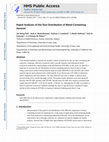
Aerosol Science and Technology, Oct 28, 2016
Conventional methods to measure the metallic content of particles by size are time consuming and ... more Conventional methods to measure the metallic content of particles by size are time consuming and expensive, requiring collection of particles with a cascade impactor and subsequent metals analysis by inductively coupled plasma mass spectrometry (ICP-MS). In this work, we describe a rapid way to measure the size distribution of metal-containing particles from 10 nm to 20 μm, using a nano micro-orifice uniform-deposit impactor (nano-MOUDI) to size-selective and collect particles that are then analyzed with a field portable X-ray fluorescence (FP-XRF) to determine metal composition and concentration. The nano-MOUDI was used to sample a stainless-steel aerosol produced by a spark discharge system. The particle-laden substrates were then analyzed directly with FP-XRF and then with ICP-MS. Results from FP-XRF were linearly correlated with results from ICP-MS (R 2 = 0.91 for Fe and R 2 = 0.84 for Cr). Although the FP-XRF was unable to detect Fe particles at mass per substrate loadings less than 2.5 μg effectively, it produced results similar to those using the ICP-MS at a mass per substrate loading greater than 2.5 μg.

Nano–Bio Interactions of Porous and Nonporous Silica Nanoparticles of Varied Surface Chemistry: A Structural, Kinetic, and Thermodynamic Study of Protein Adsorption from RPMI Culture Medium
Langmuir, Jan 12, 2016
Understanding complex chemical changes that take place at nano-bio interfaces is of great concern... more Understanding complex chemical changes that take place at nano-bio interfaces is of great concern for being able to sustainably implement nanomaterials in key applications such as drug delivery, imaging, and environmental remediation. Typical in vitro assays use cell viability as a proxy to understanding nanotoxicity but often neglect how the nanomaterial surface can be altered by adsorption of solution-phase components in the medium. Protein coronas form on the nanomaterial surface when incubated in proteinaceous solutions. Herein, we apply a broad array of techniques to characterize and quantify protein corona formation on silica nanoparticle surfaces. The porosity and surface chemistry of the silica nanoparticles have been systematically varied. Using spectroscopic tools such as FTIR and circular dichroism, structural changes and kinetic processes involved in protein adsorption were evaluated. Additionally, by implementing thermogravimetric analysis, quantitative protein adsorption measurements allowed for the direct comparison between samples. Taken together, these measurements enabled the extraction of useful chemical information on protein binding onto nanoparticles in solution. Overall, we demonstrate that small alkylamines can increase protein adsorption and that even large polymeric molecules such as poly(ethylene glycol) (PEG) cannot prevent protein adsorption in these systems. The implications of these results as they relate to further understanding nano-bio interactions are discussed.
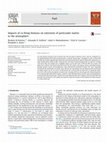
Fuel, Dec 1, 2015
Gas and particle emissions from co-firing coal and two types of biomass versus coal was evaluated... more Gas and particle emissions from co-firing coal and two types of biomass versus coal was evaluated in a circulating fluidized bed boiler operating with a constant energy input. Compared to coal, co-firing 50% oat hulls (by weight) significantly reduced the emission of particulate matter (PM) by 90%, polycyclic aromatic hydrocarbons (PAH) by 40%, metals by 65%, and fossil carbon dioxide by 40%. In contrast, co-firing 3.8% wood chips (by weight) had a negligible impact on the emissions of PM and PAH, but caused a 6% reduction in metals. Fuel-based emission factors for PM, metals, and organic species including biomass burning markers retene and levoglucosan, were determined. Enrichment factors (EF) were computed to examine the distribution of metals across PM, fly ash, and bottom ash and demonstrated enrichment in volatile metals (e.g. Fe, Al, and Cr) in PM and fly ash. Co-firing 50% oat hulls led to a significant depletion of K in PM and its enrichment in bottom ash. Scanning electron microscopy with energy-dispersive X-ray spectroscopy (SEM-EDX) analysis revealed a wide heterogeneity in particle sizes and compositions across particles for all fuel types. Overall, this study demonstrates that co-firing a 50% oat hulls with coal provides several benefits to air quality and outlines important changes to PM composition when biomass is co-fired with coal.
Biological and environmental media control oxide nanoparticle surface composition: the roles of biological components (proteins and amino acids), inorganic oxyanions and humic acid
Environmental science. Nano, 2015
Evolution of nanoparticle surface composition in increasingly complex biological and environmenta... more Evolution of nanoparticle surface composition in increasingly complex biological and environmental matrices.

<b>Accurate Quantification of TiO</b><sub><b>2</b></sub><b>Nanoparticles Collected on Air Filters Using a Microwave-Assisted Acid Digestion Method</b>
<div><p>ABSTRACT</p><p>Titanium dioxide (TiO<sub>2</sub>) par... more <div><p>ABSTRACT</p><p>Titanium dioxide (TiO<sub>2</sub>) particles, including nanoparticles with diameters smaller than 100 nm, are used extensively in consumer products. In a 2011 current intelligence bulletin, the National Institute of Occupational Safety and Health (NIOSH) recommended methods to assess worker exposures to fine and ultrafine TiO<sub>2</sub> particles and associated occupational exposure limits for these particles. However, there are several challenges and problems encountered with these recommended exposure assessment methods involving the accurate quantitation of titanium dioxide collected on air filters using acid digestion followed by inductively coupled plasma optical emission spectroscopy (ICP-OES). Specifically, recommended digestion methods include the use of several hazardous chemicals, such as perchloric acid, which are typically unavailable in most accredited industrial hygiene laboratories. Other alternative methods that are used typically involve the use of nitric acid or combination of nitric acid and sulfuric acid, which yield very poor recoveries for titanium dioxide. Therefore, given the current state of the science, it is clear that a newer safe, reliable method is needed for exposure assessment. In this current study, a microwave-assisted acid digestion method has been specifically designed to improve the recovery of titanium in TiO<sub>2</sub> nanoparticles for analysis using ICP-OES. The optimum digestion conditions were determined by changing several variables including the acids used, digestion time and temperature. Consequently, the optimized digestion temperature of 210°C with concentrated sulfuric and nitric acid (2:1 v/v) resulted in a recovery of >90% for TiO<sub>2</sub>. The method is expected to provide for a more accurate quantification of airborne TiO<sub>2</sub> particles in the workplace environment.</p></div
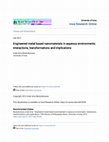
Nanoscience and nanotechnology offer potential routes towards addressing critical issues such as ... more Nanoscience and nanotechnology offer potential routes towards addressing critical issues such as clean and sustainable energy, environmental protection and human health. Specifically, metal based nanomaterials are found in a wide range of applications and therefore hold a greater potential of possible release into the environment or for the human to be exposed. Understanding the aqueous phase behavior of metal and metal oxide nanomaterials is a key factor in the safe design of these materials because their interactions with living systems are always mediated through the aqueous phase. Broadly the transformations in the aqueous phase can be classified as dissolution, aggregation and adsorption which are dependent and linked processes to one another. The complexity of these processes at the liquid-solid interface has therefore been one of the grand challenges that has persisted since the beginning of nanotechnology. Although classical models provide guidance for understanding dissolution and aggregation of nanoparticles in water, there are many uncertainties associated with the recent findings. This is often due to a lack of fundamental knowledge of the surface structure and surface energetics for very small particles. Therefore currently the environmental health and safety studies related to nanomaterials are more focused on understanding the surface chemistry that governs the overall processes in the liquid-solid interfacial region at the molecular level. The metal based nanomaterials focused on in this dissertation include TiO2, ZnO, Cu and CuO. These are among the most heavily used in a number of applications ranging from uses in the construction industry to cosmetic formulation. Therefore they are produced in large scale and have been detected in the environment. There is debate within the scientific community related to their safety as a result of the lack of v understanding on the surface interactions that arise from the detailed nature of the surfaces. Specifically, the interactions of these metal and metal oxide nanoparticles with environmental and biological ligands in the solutions have demonstrated dramatic alterations in their aqueous phase behavior in terms of dissolution and aggregation. Dissolution and aggregation are among the determining factors of nanoparticle uptake and toxicity. Furthermore, solution conditions such as ionic strength and pH can act as controlling parameters for surface ligand adsorption while adsorbed ligands themselves undergo surface induced structural and conformational changes. Because, nanomaterials in both the environment and in biological systems are subjected to a wide range of matrix conditions they are in fact dynamic entities. Thus monitoring and tracking these nanomaterials in real systems is extremely challenging and requires a thorough understanding of the surface chemistry governing their transformations. The work presented in this dissertation attempts to bridge the gap between the dynamic processing of these nanomaterials, the details of the molecular processes that occur at the liquid-solid interfacial region and potential interactions. Extensive nanomaterial characterization is an integral part of these investigations and all the materials presented are thoroughly analyzed for particle size, shape, surface area, bulk and surface compositions. Detailed spectroscopic analysis was used to acquire molecular information of the processes in the liquid-solid interfacial region and the outcomes are linked with the macroscopic analysis with the aid of light scattering techniques. Furthermore, emphasis is given to the size dependent behavior and theoretical modeling is adapted giving careful consideration to the details of the physicochemical characterization and molecular information unique to the nanomaterials.
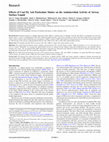
Environmental Health Perspectives, 2017
BACKGROUND: Sustained exposure to ambient particulate matter (PM) is a global cause of mortality.... more BACKGROUND: Sustained exposure to ambient particulate matter (PM) is a global cause of mortality. Coal fly ash (CFA) is a byproduct of coal combustion and is a source of anthropogenic PM with worldwide health relevance. The airway epithelia are lined with fluid called airway surface liquid (ASL), which contains antimicrobial proteins and peptides (AMPs). Cationic AMPs bind negatively charged bacteria to exert their antimicrobial activity. PM arriving in the airways could potentially interact with AMPs in the ASL to affect their antimicrobial activity. OBJECTIVES: We hypothesized that PM can interact with ASL AMPs to impair their antimicrobial activity. METHODS: We exposed pig and human airway explants, pig and human ASL, and the human cationic AMPs b-defensin-3, LL-37, and lysozyme to CFA or control. Thereafter, we assessed the antimicrobial activity of exposed airway samples using both bioluminescence and standard colonyforming unit assays. We investigated PM-AMP electrostatic interaction by attenuated total reflection Fourier-transform infrared spectroscopy and measuring the zeta potential. We also studied the adsorption of AMPs on PM. RESULTS: We found increased bacterial survival in CFA-exposed airway explants, ASL, and AMPs. In addition, we report that PM with a negative surface charge can adsorb cationic AMPs and form negative particle-protein complexes. CONCLUSION: We propose that when CFA arrives at the airway, it rapidly adsorbs AMPs and creates negative complexes, thereby decreasing the functional amount of AMPs capable of killing pathogens. These results provide a novel translational insight into an early mechanism for how ambient PM increases the susceptibility of the airways to bacterial infection.
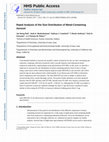
Aerosol Science and Technology, 2016
Conventional methods to measure the metallic content of particles by size are time consuming and ... more Conventional methods to measure the metallic content of particles by size are time consuming and expensive, requiring collection of particles with a cascade impactor and subsequent metals analysis by inductively coupled plasma mass spectrometry (ICP-MS). In this work, we describe a rapid way to measure the size distribution of metal-containing particles from 10 nm to 20 μm, using a nano micro-orifice uniform-deposit impactor (nano-MOUDI) to size-selective and collect particles that are then analyzed with a field portable X-ray fluorescence (FP-XRF) to determine metal composition and concentration. The nano-MOUDI was used to sample a stainless-steel aerosol produced by a spark discharge system. The particle-laden substrates were then analyzed directly with FP-XRF and then with ICP-MS. Results from FP-XRF were linearly correlated with results from ICP-MS (R 2 = 0.91 for Fe and R 2 = 0.84 for Cr). Although the FP-XRF was unable to detect Fe particles at mass per substrate loadings less than 2.5 μg effectively, it produced results similar to those using the ICP-MS at a mass per substrate loading greater than 2.5 μg.
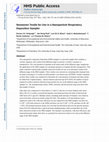
Journal of Occupational and Environmental Hygiene, 2016
The nanoparticle respiratory deposition (NRD) sampler is a personal sampler that combines a cyclo... more The nanoparticle respiratory deposition (NRD) sampler is a personal sampler that combines a cyclone, impactor, and a nylon mesh diffusion stage to measure a worker's exposure to nanoparticles. The concentration of titanium in the nylon mesh of the diffusion stage complicates the application of the NRD sampler for assessing exposures to titanium dioxide nanoparticles. This study evaluated commercially available nonwoven textiles for use as an alternative media in the diffusion stage of the NRD sampler. Three textiles were selected as containing little titanium from an initial screening of 11 textiles by field portable x-ray fluorescence (FPXRF). Further evaluation on these three textiles was conducted to determine the concentration of titanium and other metals by inductively coupled plasma -optical emission spectroscopy (ICP-OES), the number of layers required to achieve desired collection characteristics for use as the diffusion stage in the NRD sampler (i.e., the nanoparticulate matter, NPM, criterion), and the pressure drop associated with that number of layers.
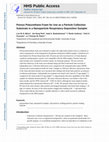
Aerosol Science and Technology, 2016
Porous polyurethane foam was evaluated to replace the eight nylon meshes used as a substrate to c... more Porous polyurethane foam was evaluated to replace the eight nylon meshes used as a substrate to collect nanoparticles in the Nanoparticle Respiratory Deposition (NRD) sampler. Cylindrical (25mm diameter by 40-mm deep) foam with 110 pores per inch was housed in a 25-mm-diameter conductive polypropylene cassette cowl compatible with the NRD sampler. Pristine foam and nylon meshes were evaluated for metals content via elemental analysis. The size-selective collection efficiency of the foam was evaluated using salt (NaCl) and metal fume aerosols in independent tests. Collection efficiencies were compared to the nanoparticulate matter (NPM) criterion and a semi-empirical model for foam. Changes in collection efficiency and pressure drop of the foam and nylon meshes were measured after loading with metal fume particles as measures of substrate performance. Substantially less titanium was found in the foam (0.173 μg sampler -1 ) compared to the nylon mesh (125 μg sampler -1 ), improving the detection capabilities of the NRD sampler for titanium dioxide particles. The foam collection efficiency was similar to that of the nylon meshes and the NPM criterion (R 2 = 0.98, for NaCl), although the semi-empirical model underestimated the experimental efficiency (R 2 = 0.38). The pressure drop across the foam was 8% that of the nylon meshes when pristine and changed minimally with metal fume loading (~ 19 mg). In contrast, the pores of the nylon meshes clogged after loading with ~ 1 mg metal fume. These results indicate that foam is a suitable substrate to collect metal (except for cadmium) nanoparticles in the NRD sampler.
Environmental Science: Nano, 2016
The increasing use of copper oxide (CuO) nanoparticles (NPs) in medicine and industry demands an ... more The increasing use of copper oxide (CuO) nanoparticles (NPs) in medicine and industry demands an understanding of their potential toxicities.
Effects of Eyjafjallajökull volcanic ash on innate immune system responses and bacterial growth in vitro
Environmental Health Perspectives, 2013
NanoEHS – defining fundamental science needs: no easy feat when the simple itself is complex
Environmental Science: Nano, 2016
Bridging knowledge gaps in NanoEHS by identifying current fundamental science challenges and rese... more Bridging knowledge gaps in NanoEHS by identifying current fundamental science challenges and research needs.
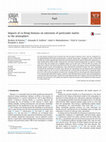
Fuel, 2015
Gas and particle emissions from co-firing coal and two types of biomass versus coal was evaluated... more Gas and particle emissions from co-firing coal and two types of biomass versus coal was evaluated in a circulating fluidized bed boiler operating with a constant energy input. Compared to coal, co-firing 50% oat hulls (by weight) significantly reduced the emission of particulate matter (PM) by 90%, polycyclic aromatic hydrocarbons (PAH) by 40%, metals by 65%, and fossil carbon dioxide by 40%. In contrast, co-firing 3.8% wood chips (by weight) had a negligible impact on the emissions of PM and PAH, but caused a 6% reduction in metals. Fuel-based emission factors for PM, metals, and organic species including biomass burning markers retene and levoglucosan, were determined. Enrichment factors (EF) were computed to examine the distribution of metals across PM, fly ash, and bottom ash and demonstrated enrichment in volatile metals (e.g. Fe, Al, and Cr) in PM and fly ash. Co-firing 50% oat hulls led to a significant depletion of K in PM and its enrichment in bottom ash. Scanning electron microscopy with energy-dispersive X-ray spectroscopy (SEM-EDX) analysis revealed a wide heterogeneity in particle sizes and compositions across particles for all fuel types. Overall, this study demonstrates that co-firing a 50% oat hulls with coal provides several benefits to air quality and outlines important changes to PM composition when biomass is co-fired with coal.
Biological and environmental media control oxide nanoparticle surface composition: the roles of biological components (proteins and amino acids), inorganic oxyanions and humic acid
Environmental Science: Nano, 2015
Evolution of nanoparticle surface composition in increasingly complex biological and environmenta... more Evolution of nanoparticle surface composition in increasingly complex biological and environmental matrices.
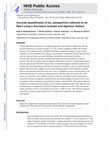
Journal of Occupational and Environmental Hygiene, 2016
Titanium dioxide (TiO 2 ) particles, including nanoparticles with diameters smaller than 100 nm, ... more Titanium dioxide (TiO 2 ) particles, including nanoparticles with diameters smaller than 100 nm, are used extensively in consumer products. In a 2011 current intelligence bulletin, the National Institute of Occupational Safety and Health (NIOSH) recommended methods to assess worker exposures to fine and ultrafine TiO 2 particles and associated occupational exposure limits for these particles. However, there are several challenges and problems encountered with these recommended exposure assessment methods involving the accurate quantitation of titanium dioxide collected on air filters using acid digestion followed by inductively coupled plasma optical emission spectroscopy (ICP-OES). Specifically, recommended digestion methods include the use of chemicals, such as perchloric acid, which are typically unavailable in most accredited industrial hygiene laboratories due to highly corrosive and oxidizing properties. Other alternative methods that are used typically involve the use of nitric acid or combination of nitric acid and sulfuric acid, which yield very poor recoveries for titanium dioxide. Therefore, given the current state of the science, it is clear that a new method is needed for exposure assessment. In this current study, a microwave-assisted acid digestion method has been specifically designed to improve the recovery of titanium in TiO 2 nanoparticles for quantitative analysis using ICP-OES. The optimum digestion conditions were determined by changing several variables including the acids used, digestion time, and temperature. Consequently, the optimized digestion temperature of 210°C with concentrated sulfuric and nitric acid (2:1 v/v) resulted in a recovery of >90% for TiO 2 . The method is expected to provide for a more accurate quantification of airborne TiO 2 particles in the workplace environment.
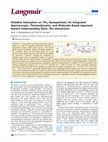
Langmuir, 2014
Nanoparticles in biological media form dynamic entities as a result of competitive adsorption of ... more Nanoparticles in biological media form dynamic entities as a result of competitive adsorption of proteins on nanoparticle surfaces called protein coronas. The protein affinity toward nanoparticle surfaces potentially depends on the constituent amino acid side chains which are on the protein exterior and thus exposed to the solution and available for interaction. Therefore, studying the adsorption of individual amino acids on nanoparticle surfaces can provide valuable insights into the overall evolution of nanoparticles in solution and the protein corona that forms. In the current study, the surface adsorption of L-histidine on TiO 2 nanoparticles with a diameter of 5 nm at pH 7.4 (physiological pH) is studied from both macroscopic and molecular perspectives. Quantitative adsorption measurements of L-histidine on 5 nm TiO 2 particles yield maximum adsorption coverage of 6.2 ± 0.3 × 10 13 molecules cm -2 at 293 K and pH 7.4. These quantitative adsorption measurements also yield values for the equilibrium constant and free energy of adsorption of K = 4.3 ± 0.5 × 10 2 L mol -1 and ΔG = -14.8 ± 0.3 kJ mol -1 , respectively. Detailed analysis of the adsorption between histidine and 5 nm TiO 2 nanoparticle surfaces with attenuated total reflectance Fourier transform infrared (ATR-FTIR) spectroscopy indicates both the imidazole side chain and the amine group interacting with the nanoparticle surface and the adsorption to be reversible. The adsorption results in no change in surface charge and therefore does not change nanoparticle-nanoparticle interactions and thus aggregation behavior of these 5 nm TiO 2 nanoparticles in aqueous solution.

Aerosol Science and Technology, 2015
A granular bed was designed to collect nanoparticles as an alternative to nylon mesh screens for ... more A granular bed was designed to collect nanoparticles as an alternative to nylon mesh screens for use in a nanoparticle respiratory deposition (NRD) sampler. The granular bed consisted of five layers in series: a coarse mesh, a large-bead layer, a small-bead layer, a second large-bead layer, and a second coarse mesh. The bed was designed to primarily collect particles in the small-bead layer, with the coarse mesh and large-bead layers designed to hold the collection layer in position. The collection efficiency of the granular bed was measured for varying depths of the small-bead layer and for test particles with different shape (cuboid, salt particles; and fractal, and stainless steel and welding particles). Experimental measurements of collection efficiency were compared to estimates of efficiency from theory and to the nanoparticulate matter (NPM) criterion, which was established to reflect the total deposition in the human respiratory system for particles smaller than 300 nm. The shape of the collection efficiency curve for the granular bed was similar to the NPM criterion in these experiments. The collection efficiency increased with increasing depth of the small-bead layer: the particle size associated with 50% collection efficiency, d 50 , for salt particles was 25 nm for a depth of 2.2 mm, 35 nm for 3.2 mm, and 45 nm for 4.3 mm. The best-fit to the NPM criterion was found for the bed with a small-bead layer of 3.2 mm. Compared to cubic salt particles, the collection efficiency was higher for fractal-shaped particles larger than 50 nm, presumably due to increased interception.
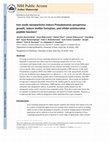
Environmental Science: Nano, 2014
Given the increased use of iron-containing nanoparticles in a number of applications, it is impor... more Given the increased use of iron-containing nanoparticles in a number of applications, it is important to understand any effects that iron-containing nanoparticles can have on the environment and human health. Since iron concentrations are extremely low in body fluids, there is potential that iron-containing nanoparticles may influence the ability of bacteria to scavenge iron for growth, affect virulence and inhibit antimicrobial peptide (AMP) function. In this study, Pseudomonas aeruginosa (PA01) and AMPs were exposed to iron oxide nanoparticles, hematite (α-Fe 2 O 3 ), of different sizes ranging from 2 to 540 nm (2 ± 1, 43 ± 6, 85 ± 25 and 540 ± 90 nm) in diameter. Here we show that the greatest effect on bacterial growth, biofilm formation, and AMP function impairment is found when exposed to the smallest particles. These results are attributed in large part to enhanced dissolution observed for the smallest particles and an increase in the amount of bioavailable iron. Furthermore, AMP function can be additionally impaired by adsorption onto nanoparticle surfaces. In particular, lysozyme readily adsorbs onto the nanoparticle surface which can lead to loss of peptide activity. Thus, this current study shows that co-exposure of nanoparticles and known pathogens can impact host innate immunity. Therefore, it is important that future studies be designed to further understand these types of impacts. † Electronic supplementary information (ESI) available: ESI contains a detailed description of particle synthesis and sources and a schematic diagram of the antimicrobial peptide assay. See
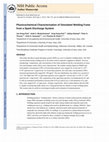
Aerosol science and technology : the journal of the American Association for Aerosol Research, 2014
This study introduces spark discharge system (SDS) as a way to simulate welding fumes. The SDS wa... more This study introduces spark discharge system (SDS) as a way to simulate welding fumes. The SDS was developed using welding rods as electrodes with an optional coagulation chamber. The size, morphology, composition, and concentration of the fume produced and the concentration of ozone (O3) and nitrogen oxides (NOX) were characterized. The number median diameter (NMD) and total number concentration (TNC) of fresh fume particles were ranged 10-23 nm and 3.1×10(7)-6×10(7) particles/cm(3), respectively. For fresh fume particles, the total mass concentration (TMC) measured gravimetrically ranged 85-760 μg/m(3). The size distribution was stable over a period of 12 h. The NMD and TNC of aged fume particles were ranged 81-154 nm and 1.5×10(6)-2.7×10(6) particles/cm(3), respectively. The composition of the aged fume particles was dominated by Fe and O with an estimated stoichiometry between that of Fe2O3 and Fe3O4. Concentrations of O3 and NOX were ranged 0.07-2.2 ppm and 1-20 ppm, respective...










Uploads
Papers by Imali Mudunkotuwa